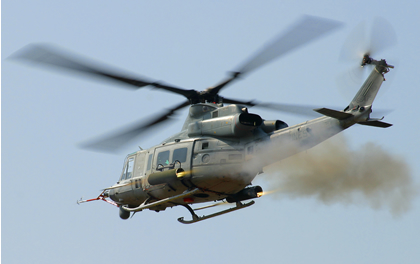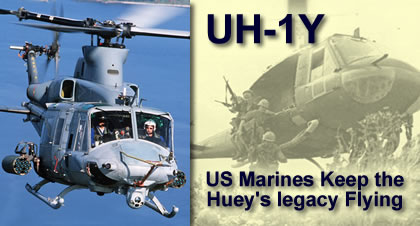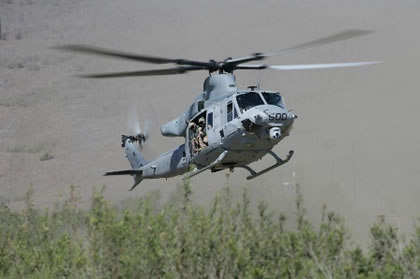US Marines Keep the Huey’s legacy Flying
The Marine Corps’s newest utility helicopters, the UH-1Y Venom, achieved Initial Operating Capability this month, as Lt. Gen. George Trautman of USMC Headquarters at Quantico confirmed that three aircraft have met all flight requirements and are ready for deployment. In January 2009, the UH-1Y will be sent on its first scheduled deployment with the 13th Marine Expeditionary Unit (MEU) aboard the USS Boxer.
Part of the USMC H-1 upgrade program, the new the four-bladed, twin engine UH-1Y replaces the currently fielded UH-1N. This upgrade will help meet the Marine Corps’ 21st century mission for rotary-wing utility and attack aircraft. The total program requirement for the UH-1Y is 123 helicopters. Delivery is expected to be complete by the end of fiscal 2016.
Within the familiar silhouette and proven heritage of the UH-1, the Y model applies a new four blade rotor system, fitted with all-composite and ballistically tolerants made of composite materials. It is poweerd by two General Electric T700-GE-401C engines, offering 125% higher payload, compared to current UH-1Ns. modern night-vision integrated “glass cockpit” and advanced mission systems.
A Tough Warfighter
The UH-1Y provides about 50% increased range, compared to the UH-1N. It also has a higher maximum speed, and stronger airframe designed for sustainable high G loads in tactical or evasive maneuvers, better ballistic tolerance and crash survivability. The airframe is designed with mass retention features, to ensure major components stay where they should in the event of a crash. Energy attenuating seats are installed in the cockpit and cabin, to protect crewmembers and eight passengers from injury on hard landing. Energy-absorbing landing gear also helps attenuating hard landing. In an event of a crash, the crashworthy fuel system, comprising self sealing fuel tanks and fuel systems and fuel vapor inerting systems, further reducing the risk of fire.
Advanced Avionics
The helicopter is fitted with comprehensive electronic warfare self protection (EWSP) suite, and ballistic hardened components, protect it from a broad range of modern threat weapons. EWSP includes the AVR-2A Laser Warning Receiver, APR-39A(v) 2 Radar Warning Receiver, AAR-47 Missile Warning Device and ALE-47 “Smart” Countermeasures Dispenser.
FLIR Systems, Inc., BRITE Star Night Vision Thermal Imaging System (NTIS) is standard issue on the UH-1Y, mounted under the nose of the aircraft for targeting and night imaging. The sensor images are displayed on selected multifunction displays in the cockpit. Another advanced vision system is the “Top Owl” Helmet Mounted Sight and Display (HMS/D) developed by Thales Avionics. The helmet enhances the pilot’s flying and situational awareness during night and adverse weather operations, by reducing the workload and highlighting critical flight data.
Common Support Benefit the Entire Corps’ H-1 Fleet
On the ground, the new version of the Huey is designed to improve logistics footprint and reduce in life-cycle costs, introducing commonality through the H-1 fleet (UH-1Y and AH-1Z). The UH-1Y and AH-1Z have 84% commonality with identical components. The UH-1Y modernizatio is part of a comprehensive ‘H-1 Upgrades Program’ launched by the Marine Corps, replacing the current H-1 fleet with 90 newly built UH-1Ys, 10 remanufactured UH-1Ys and 180 remanufactured AH-1Zs.
According to the manufacturer, the UH-1Y comes “wet assembled” and incorporates aluminum transmission cases to prevent corrosion. Furthermore, reduced vibration level mean not only more comfortable flight, but also extended life for most of the mechanical and electronic systems on board. With unique semi-automatic main rotor blade folding capability, this helicopter moves and stores easily in confined areas.
Maintenance personnel will find the new helicopter more accessibility, and easier to work with, since Bell eliminated certain maintenance tasks, reducing the man hours per flight hour, and spare consumption requirements. The new helicopter is designed for lower maintenance – with modern fault detection sensors and Interactive Electronic Technical Manuals facilitating “on-condition” maintenance. Shared dynamics and nearly identical cockpits vastly reduces the logistical tail, procurement and training costs required to support a large fleet of mixed type aircraft.






















